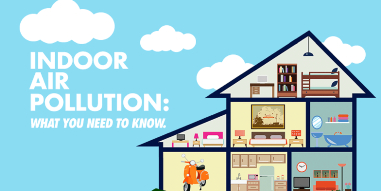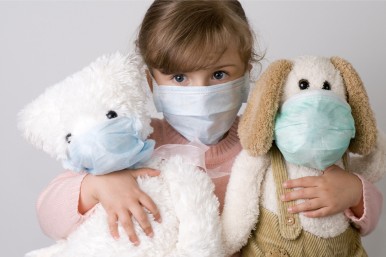By Registered Health Visitor – Julia Headland

Introduction
This month’s blog was a real eye opener to me as a healthcare professional and, as a result of researching and writing it, I have made some immediate changes in my home and have seen some positive changes. For example, for the last 2 years or so, I had developed a strange rhinitis that was not seasonal. It had become so bad that it was affecting my sleep and I racked my brain wondering what the cause was and I had convinced myself it was a particular perfume or fabric softener but even though I changed these, the rhinitis continued. By chance however, I had a conversation with a friend who mentioned that she had been given a perfumed reed diffuser for her birthday but as soon as she put it in her house, she developed rhinitis and wheezing and so removed it and her rhinitis disappeared. This really resonated with me as I had 3 of these diffusers scattered around the house and had them for years so I promptly threw them all away. I would say that within 2 weeks, probably the time it took for all the fumes in the air to dissipate, the rhinitis completely disappeared, and I have never had it since. I assumed that I had a one-off allergy to these diffusers but on researching this topic, I am surprised to discover that these indoor air fresheners and smelly candles are contributing to harmful indoor air pollution.
Indoor Air Pollution and our Homes
Did you know that indoor pollution is a very real threat to our children’s health and research from the Royal College of Paediatric and Child health (2020) supports this and reports the mounting evidence linking indoor pollution to children’s ill health. It is even reported that indoor air can be up to seven times more polluted than outside air and much of this pollution from sources within the home.
So, what is causing this pollution that is potentially harming our children?
Some of the pollution inducing in our homes can’t be helped, for example, some of the measures we do to conserve heat in the winter reduces our ventilation in the home and therefore increases air pollution. Also, children are spending much more time indoors than in previous decades, not to mention the last year of enforced lockdowns. You might think that this pollution is reserved for urban areas, but research has shown there is no evidence to suggest that rural areas are safer than urban areas.
What is Polluting our Homes?
- Biological pollutants such as dust mites, bacteria, viruses, mould and mildew and pet dander
- Carbon monoxide and nitrogen dioxide from tobacco smoke, open fires, wood burning stoves, gas cookers/heating.
- Formaldehyde from building materials, furniture and household products.
- Particulate matter (inhalable solid particles) comprising of a huge variety of chemical compounds that result from transport, smoking, cooking, cleaning and burning (including fires, stoves, candles and incense).
- Volatile organic compounds (VOC’S) that are emitted from thousands of household products such as cleaning and personal care products, furniture, carpets, building materials, paints, solvents, air fresheners, and tobacco smoke.
- Airborne plastics mostly from the breakdown of manmade clothing.
- Pesticides such as insecticides and antimicrobial disinfectants.
- Radon, a radioactive carcinogenic gas naturally present in some soil and rock that can enter buildings through the ground and cracks in the walls.
Clearly there are some of the above contributors that we are unable to control but there are also many that we can. Pollution is a public health concern for all people but unfortunately infants are especially vulnerable. Children breathe faster than adults due to a higher resting metabolic rate: infants breathe 3 x as much as air as adults and six-year-olds breathe twice as much air as adults and consequently the more air they breathe in, the more pollutants they breathe in relative to their body weight. Children also have a larger lung surface area relative to body weight than adults which enables them to have greater absorption of pollutants.
So how can the Health Effects from Indoor Pollution Manifest in Children?
Birth and Infancy
- Respiratory problems- wheeze, rhinitis, atopic eczema, respiratory infections,
- Low birth weight and preterm birth
Pre-School
- Respiratory problems- wheeze, allergies, asthma, risk of respiratory diseases and pneumonia.
- Eczema and atopic dermatitis
- Greater hyperactivity, impulsivity and inattention
School age

- Respiratory problems- wheeze, allergies, rhinitis, throat irritation, nasal congestion,
- Dry cough
- Eczema, dermatitis, conjunctivitis, skin and eye irritation
- Reduced cognitive performance, difficulty sleeping.
Protection Measures
Thankfully, there are some simple measures that we can take to reduce indoor air pollution and it’s worth noting that if your child is suffering with any of the above, simply analysing your home and looking for things such as air fresheners, household cleaning products, indoor smoke for cigarettes or fires, nice smelling candles or incense. The following are some other simple measures to help reduce indoor pollution in your home:
- Increase Ventilation. Open windows, especially if you are cooking and cleaning and other activities that create moisture.
- Use a Cooker-hood or Extractor Fan. When cooking, use an extractor fan and try and use the back rings on the stove to maximise the extraction of pollutants. Also avoid burning food.
- Consider Cooking Type. Electricity is less polluting than gas. Advise to stay out if the kitchen when your oven is on a self-cleaning mode.
- Reduce Damp and Condensation. Prevent mould by avoiding any moisture producing activities such as air-drying clothes indoors.
- Choose low VOC Household Products. Try using unperfumed cleaning products and try to reduce the number of different cleaning products you are using at once to avoid them mixing in the air. Choose low emission materials in floors and really try to reduce or ideally eliminate air fresheners and cosmetic products such as perfume and hairspray.
- Avoid Tobacco Smoking Indoors. Also, there is very limited evidence known on the impact of e-cigarettes and vaping on air quality so until this is known, the Royal College of paediatrics and child heath advises avoiding this indoors.
- Avoid using Candles and Incense.
- Choose Natural Materials. Materials such as wool or cotton should be chosen over synthetic fibres such as polyester and nylon. Also avoid plastic toys and furniture if possible.
- Regularly Clean and Dust. This will reduce dust. It is also advised to clean textiles and bedding regularly.
- Reduce the Spread of Germs. This can be done by covering nose and mouth when coughing and sneezing.
- Have Plants Indoors. Low light requiring plants such as English Ivy, mother in laws tongue, ficus, bamboo palm and Chinese evergreen remove organic pollutants from the air in your house.
- Consider Buying an Air Purifier. There is evidence to support that air purifiers can be effective in removing common household pollutants including viruses and bacteria.
_________________________________________________________________________________________________________
For those people I have not yet met, my name is Julia Headland and I am a registered health visitor and registered general nurse with a degree in public health and over 20 years of experience. I am very pleased to work alongside the Norfolk House Nursery team.
You can arrange to meet me for confidential advice or guidance about your child’s health or development; during the pandemic these consultations are being conducted by Zoom or telephone.
My consultations are free of charge and they are confidential.
You can book an appointment with me via the Norfolk House Nursery staff.
You can also follow me on Facebook, by clicking here.
